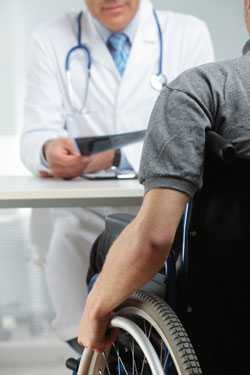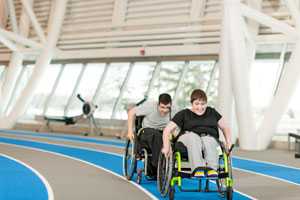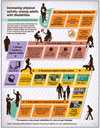Increasing Physical Activity among Adults with Disabilities
Resources for Doctors and Health Professionals
More than 21 million US adults 18 – 64 years of age have a disability. These are adults with serious difficulty walking or climbing stairs; hearing; seeing; or concentrating, remembering, or making decisions. Adults with disabilities are three times more likely to have heart disease, stroke, diabetes, or cancer than adults without disabilities. Aerobic physical activity can help reduce the impact of these chronic diseases, yet nearly half of all adults with disabilities get no leisure time aerobic physical activity.
Doctors and other Health Professionals can Play a Role
Increasing Physical Activity among Adults with Disabilities Infographic
Vital Signs™ Webinars:
Physical Activity is for Everybody!
May 18, 2015
Click here to see a recording of this webinar
More adults with disabilities need physical activity –
How can health professionals help?
May 20, 2014
Doctors and other health professionals can play a role in promoting physical activity among their adult patients with disabilities. Adults with disabilities were 82% more likely to be physically active if their doctor recommended it, than if they did not get a doctor recommendation. However, only 44% of adults with disabilities who visited a doctor in the past year received a physical activity recommendation from their doctor.
Doctors and other health professionals can use these 5 steps to increase physical activity among adults with disabilities:
- Remember that Physical Activity Guidelines are for Everybody
- Ask about Physical Activity
- Discuss Barriers to Physical Activity
- Recommend Physical Activity Options
- Refer Patients to Resources and Programs
Remember To:
- Look beyond the disability and put the person first. Use People-first language terms such as "person with a disability" instead of "disabled" or "handicapped person".
- Use the teach-back method to make sure your patient understands the recommendations.
Remember the Physical Activity Guidelines are for Everybody
Doctors and other health professionals should recommend physical activity, based on the 2008 Physical Activity Guidelines, to their patients with disabilities. Adults of all shapes, sizes, and abilities can benefit from being physically active, including those with disabilities.
2008 Physical Activity Guidelines
- All adults should avoid inactivity. Some physical activity is better than none, and adults who participate in any amount of physical activity gain some health benefits.
- Aerobic activity should be performed in episodes of at least 10 minutes, and preferably it should be spread throughout the week.
For important health benefits, all adults should do both aerobic and muscle-strengthening physical activities.
For Aerobic:
- at least 2 hours and 30 minutes (150 minutes) a week of moderate-intensity aerobic physical activity (i.e., brisk walking; wheeling oneself in a wheelchair); or
- 1 hour and 15 minutes (75 minutes) a week of vigorous-intensity aerobic physical activity (i.e., jogging, wheelchair basketball); or
- a mix of both moderate- and vigorous-intensity aerobic physical activities each week. A rule of thumb is that 1 minute of vigorous-intensity activity is about the same as 2 minutes of moderate-intensity activity.
For Muscle-Strengthening:
- activities that are moderate or high intensity and involve all major muscle groups on 2 or more days a week (i.e., working with resistance bands; adapted yoga) as these activities provide additional health benefits.
Key Guidelines for Adults with Disabilities
- When adults with disabilities are not able to meet the above Guidelines, they should engage in regular physical activity according to their abilities and should avoid inactivity.
- Adults with disabilities should talk to their doctor about the amounts and types of physical activity that are appropriate for their abilities.
Download the Physical Activity Guidelines (PDF).
Ask About Physical Activity

Doctors should recommend to their adult patients with disabilities to get physical activity on a regular basis that is consistent with their abilities. Doctors can ask about physical activity levels of their patients with disabilities by asking questions such as:
- How much physical activity are you currently doing each week?
- How often?
- How long?
- At what intensity level?
- What types of physical activity do you enjoy, now or in the past?
- How can you add more physical activity to your life?
Additional guidance can be adapted from Exercise is Medicine™ Health Care Providers Action Guide
Discuss Barriers with Patients
Adults with disabilities face barriers to getting aerobic physical activity. Discuss the following barriers with your patients with disabilities to help them find ways to get physical activity in the built and natural environment, including:
- Knowing about and getting to programs, places, and spaces where they can be physically active;
- Having social support (e.g., setting up a buddy system, making contracts with others to complete specified levels of physical activity, or setting up walking groups or other groups to provide friendship and support) for physical activity;
- Having limited information about accessible facilities and programs; and
- Finding fitness and health professionals who can provide physical activity options that match their specific abilities.
Read more about physical activity barriers among adults with disabilities:
Recommend Physical Activity Options
Recommend physical activity to your patients with disabilities, but remember they need to:
- Engage in the amount and types of physical activity that are right for them;
- Find opportunities to increase regular physical activity in ways that meet their needs and abilities;
- Start slowly based on their abilities and fitness level (e.g. active for at least 10 minutes at a time, slowly increase activity over several weeks, if necessary);
- Include aerobic physical activities that make them breathe harder and their heart beat faster for important health benefits, such as reducing the risk of heart disease, stroke, diabetes, and some cancers;
- Know that most aerobic physical activity may need to be modified, adapted, or may need additional assistance or equipment; and
- Avoid being physically inactive. Some physical activity is better none.
Aerobic physical activities may include:

- Aquatic therapy
- Ballroom dancing
- Brisk walking
- Cross-country and downhill skiing
- Hand-crank bicycling
- Hiking
- Horseback riding
- Nordic Walking
- Rowing
- Seated volleyball
- Swimming laps
- Water aerobics
- Wheeling oneself in wheelchair
- Wheelchair basketball, tennis, football, or softball
Physical Activity Resources for Doctors and other Health Professionals
Use the following resources and programs to get educated on a wide range of physical activity options and to help you refer and connect your adult patients with disabilities.
For all disability types:
- 2008 Physical Activity Guidelines for Adults with Disabilities chapter provides guidance on physical activity for people with disabilities.
- ACSM ProFinder™ is a service that can help professionals and individuals find certified health and fitness professionals nearby.
- American College of Sports Medicine/National Center on Health, Physical Activity, and Disability (ASCM/NCHPAD) Certified Inclusive Fitness Trainers (CIFT) have specialized training on understanding exercise precautions for people with disabilities, and utilizing safe, effective and adapted methods of exercise training to provide exercise recommendations. CIFTs provide services with an understanding of current Americans with Disabilities Act (ADA) policy specific to recreation facilities (U.S. Access Board Guidelines) and standards for accessible facility design.
- Be Active Your Way is a guide for adults, including those with a disability, that provides everything from step-by-step instructions on getting started with physical activity to information on the actual physical activity needs of adults.
- CDC Healthy Weight Issue Briefs describe considerations that people and organizations can do to help combat obesity among people with disabilities and assist them in achieving healthy weight and an improved quality of life.
- Exercise is Medicine™ provides resources and tools for healthcare providers and health and fitness professionals to access and review every patient’s physical activity program at every visit.
- I Can Do It, You Can Do It (ICDIYCDI) program encourages people with disabilities to be physically active. Those who become advocates in the program can gain access to comprehensive toolkits on starting ICDIYCDI programs.
- National Center on Health, Physical Activity, and Disability (NCHPAD) focuses on improving the health, wellness, and quality of life of people with disabilities. The Center promotes and facilitates increased participation in all types of physical activity including exercise, recreation, leisure, and sport. NCHPAD’s goal has been to use new and emerging technologies to reach into the homes of people with disabilities and in local communities across the United States. NCHPAD continues to enhance connectivity, inclusion, and communication between disability service providers and local, county, and state public health programs. Contact NCHPAD toll-free at 1-800-900-8086 (voice and TTY) or by sending an email to email@nchpad.org.
- Exercise and Fitness Fact Sheets describes various exercise and fitness techniques, modes, methods, adaptations, programming and related exercise equipment.
- Disability/Conditions Fact Sheets describes various disabilities and health conditions as well as considerations for each related to exercise and physical activity.
- NCHPAD 14 Weeks to Healthier You is a National Center on Health, Physical Activity, and Disability based program. Those who register can access physical activity options and nutrition advice for people with disabilities – at no cost.
- How to Make Your Fitness Center Accessible: Fitness Center Makeover
- YMCA centers are internationally widespread, and provide many resources, including fitness centers with adaptive equipment, to help adults with disabilities live longer, healthier lives.
For cognitive, intellectual or developmental disabilities:
- The Arc has developed the HealthMeet® program, which leverages its national network of more than 700 Chapters, national disability organizations, public health systems, health professionals, university systems, and other key stakeholders to reduce health disparities and increase the longevity and quality of life for people with intellectual disabilities (ID) by providing free community-based health assessments and individualized recommendations for follow-up care. Contact The Arc toll-free at 1-800-433-5255, or by sending an email to info@thearc.org.
- HealthMeet® Post on the Arc’s Blog: Top 5 exercises for people with intellectual and developmental disabilities
- HealthMatters Train-the-Trainer Workshop: Becoming a Certified Trainer
- Special Olympics provide comprehensive, community-based health and wellness plus broad improvements in health systems and policies through the Healthy Communities initiative, which is supported by CDC. Special Olympics also offer a wide range of free health examinations and care through the Healthy Athletes™ program. The organization also provides tips on coaching and physical activity options for people with disabilities. Contact Special Olympics Healthy Athletes at 1-202-824-0308 or toll-free at 1-800-700-8585, or by sending an email to info@specialolympics.org.
- Sports and Physical Activity Fact Sheets and Coach Guides provide extensive free information on sports and fitness tailored to people with intellectual disabilities.
For vision or hearing loss:
- VisionAware™ is a comprehensive resource from the American Foundation for the Blind that provides basic information about adjusting to vision loss, including tips for adapting your home and daily living.
- VisionAware™ Recreational and Leisure activities that can be adapted for people who are visually impaired or have low vision.
- Exercise is Medicine™ Exercising with Hearing Loss Fact Sheet (PDF) provides tips for getting started and exercise cautions for adults with hearing loss.
For mobility limitations, limb loss or paralysis:
- Walk with Ease is a program designed by The Arthritis Foundation and is focused on helping people who suffer from arthritis get physical activity. This program was designed to help people who can stay on their feet for 10 minutes without increased pain. The program is available in classroom settings, led by a certified instructor, or can be accomplished at home.
- Christopher and Dana Reeve Paralysis Resource Center promotes the health and well-being of people living with spinal cord injury, mobility impairment, and paralysis by providing comprehensive information, resources, and referral services. Information provided by the organization includes resources on physical activity options designed for people with mobility impairments. Contact the Christopher and Dana Reeve Foundation Paralysis Resource Center toll-free at 1-800-539-7309, or by sending an email from their website.
- National Limb Loss Resource Center is dedicated to improving quality of life for amputees and their families, while also improving patient care and preventing limb loss. The organization aims to empower those with limb loss through a variety of measures, including providing physical activity options for those affected by limb loss. Contact the Amputee Coalition National Limb Loss Resource Center toll-free at 1-888-AMP-KNOW (1-888-267-5669), or by sending an email from their website
- Limb Loss Education Day allows people with limb loss to receive hands-on instruction to learn how to engage in an adaptive sport or recreation activity.
- Adapted Physical Activity for Amputees
CDC Works to Improve Physical Activity among Adults with Disabilities
CDC funds states are working to help adults with disabilities be more physically active.
Here are a few examples:
The Alabama Department of Public Health is promoting a statewide campaign, Scale Back Alabama, to encourage Alabamians to get healthier by maintaining a healthy weight and doing physical activity.
- The highlights of the program include:
- Collaborating with the Alabama Hospital Association, Blue Cross Blue Shield Alabama and the National Center on Health, Physical Activity, and Disability (NCHPAD) on Scale Back Alabama to provide a ten-week campaign to encourage adults, including adults with disabilities, to maintain a healthy weight and be physically active.
- Providing weekly inclusive health tips to participants via email on how to maintain a healthy weight, be more physically active, and eating more fruits and vegetables.
The Michigan Department of Community Health’s Disability Health Unit is provides an evidence-based, group physical activity program designed for people of all abilities.
- The highlights of the program include:
- Partnering with the Michigan Arthritis Program to expand the delivery of EnhanceFitness to adults with developmental, cognitive and mobility disabilities
- Reaching over 4000 participants with one-quarter being adults with disabilities with attendance at 90 classes across 76 sites statewide.
The South Carolina Research Foundation is providing an evidenced-based wellness program and preventing secondary debilitating conditions in people with intellectual disabilities.
- The highlight of the program include:
- Partnering with the South Carolina Department of Disabilities and Special Needs and Able-SC to promote healthy lifestyles, including physical activity through Steps to Your Health (STYH), which was developed, field-tested, and evaluated to be effective in promoting wellness and preventing secondary debilitating conditions in adults with intellectual disabilities.
- Providing a ten-week, small group instructional program with interactive lessons provided by a trained STYH instructor.
References
- Centers for Disease Control and Prevention Vital Signs. Available at https://www.cdc.gov/vitalsigns/index.html May 2014.
- Carroll D, Courtney-Long E, Stevens A, Sloan M, Lullo C, Visser S, Fox M, Armour B, Campbell V, Brown D, and Dorn, J. Disability and Physical Activity – United States, 2009-2012. MMWR. 2014.
- 2008 Physical Activity Guidelines for Americans. Washington, DC: US Department of Health and Human Services; 2008. Available at http://www.health.gov/paguidelines/guidelines/default.aspx
- Rimmer JH, Riley B, Wang E, Rauworth A, Jurkowski J. Physical activity participation among persons with disabilities: barriers and facilitators. Am J Prev Med 2004;26:419–25.
- Page last reviewed: August 1, 2017
- Page last updated: August 1, 2017
- Content source:




 ShareCompartir
ShareCompartir
